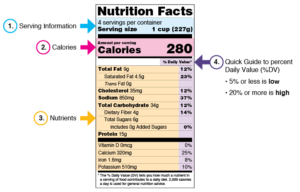Nutrition Information: How Food Labels Help You

Nutrition information on food labels has a myriad of benefits for consumers. Food labeling dates back to the 1800’s when laws for “truth in advertising” sought to protect consumers from misleading or false claims on food label packaging. Today food labels are a beacon of health offering an array of useful information to educate and empower consumers to make informed decisions about their dietary choices.
Essential information found on food labels includes calories, essential macronutrients, vitamins and minerals, ingredients, and dietary factors. Calorie information informs consumers of the energy content of the product and helps them exercise portion control and/or track their desired daily energy intake. Additionally, macronutrient content reveals how much of the product has to be consumed to meet the body’s daily dietary requirements for carbohydrates, proteins, and fats. Labels detailing the vitamin and mineral content can promote the consumption of nutritious products and alert individuals who may need to supplement their diet with additional nutrition if their needs are not being met through their food. Ingredient information can help individuals avoid ingredients that may have an adverse effect on their health, and may also influence a health professional’s diagnosis and assessment of an individual’s condition. Finally, dietary labeling in conjunction with nutritional information can provide guidance to individuals with special dietary needs such as diabetes, allergies, or religious concerns.
Beyond the standard information on food labels, manufacturers may also choose to include additional labeling such as trans-fat content or whole grain content which can further guide the consumer’s dietary choices. Some labels may also denote health claims such as “no sugar added” or “low salt” to alert the consumer to special diets they may be following. Similarly, labels may include certifications of fair-trade or organic ingredients to indicate that products were made to certain standards or regulations.
Overall, nutrition information on food labels can serve to inform and protect consumers, providing necessary details to make an informed decision on how to plan a healthy diet. With the evolution of food labeling, consumers can now feel assured that they are being provided with reliable and up-to-date nutritional information and have the power to choose what is best for their individual health.

Comments